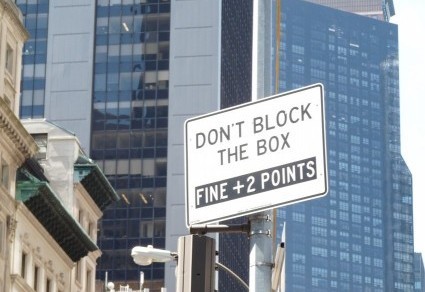A friend recently reminded me that prepositions are the “last to come and first to go” in language learning or retention. As someone who’s often placed a “por” where a “para” should be while speaking Spanish, I agree. Which leads me to the conclusion that the people creating these signs are still on their way toward mastery of English. An example from a tailor:

Note the poinsettia in the background, which presumably enjoys regular pruning and an occasional nip of fertilizer. After all, this shop brags about “all work done on our plant.” If the poinsettia isn’t the point, the preposition “on” should be “in” or “at,” explaining that the work (whatever it might be) isn’t contracted out but performed by the business itself in a factory — “our plant.”
Sometimes an “on” is present where it shouldn’t be and absent where it should be:

According to the dictionary, “premises” are buildings and the land they stand on. The conventions of English allow you to be “on” land and “in” a building. The preposition, therefore, should be a toss-up, and both “on” and “in” should work. But that’s not the case. I can’t come up with a reason why “in these premises” sounds odd. “On” fits better here. It just does.
And now a sign from a photography studio:

“In to” or “into”? “Into,” with logic behind the choice. The single word “into” shows insertion, which is what the sign warns against. The two-word version implies separate actions, going “in” and then “to” some particular place: “Go in to your friend and apologize,” said Mary standing on the lawn and pointing to the house.
One more:

You can’t have “business with” a property, because “with,” to my mind, implies a person dealing with whoever enters the service entrance. I imagine that the sign should read “on the property.” But who knows? The US Supreme Court ruled in the “Citizens United” that corporations are people, too. Maybe “with” actually fits this context.
Feel free to get in touch with, at, to, by, or for me if you have other ideas.

“isn’t contracted out by performed by the business itself in a factory ”
Bye-bye to that first “by”? Perhaps an “or” (as it sails away?), maybe a firmly-placed “but”!!
xxx,
D
Yup. “But” is what I meant. Thanks for proofing this for me!
Your remarks are all “spot on” as the Brits say! 🙂
Re “premises,” I think the reason “on” sounds better, as in “on the premises,” is that the word “premises” refers more to the ground the building is on, as opposed to the space enclosed by structure. Just my feeling. Good post!!
Thanks, Ellie. I like your theory. While the buildings are technically included, most likely people think of the ground, not the structures when they see that word.
RE: No Smoking in/on the Premises: This many be the first case where the sign maker got it right. Evidently, our senses have been warped by the many signs we’ve read that say, “No Smoking on the Premises.” Hats off to this grammar whiz . . . unless he also painted the other signs.
You’re going with “with”? Hm…m. I’ll have to think about that one. On another note, I often wonder who does make these signs and what thought process goes into them. I will probably never know. Sigh.
I often have the same thought while reading my students’ papers.
Ah, yes. My favorite student error was a reference to a “government suppository of documents.”
At least the student’s thought was logical; she just had a half-assed vocabulary. (Sorry, I couldn’t resist!)
Perfect comment!
That is the best explanation of the difference between “in to” and “into” I have ever encountered. Therefore, I must steal it to use with (by, at, in, and on) my classes!
Thanks. You can’t steal it, though, as I give it to you freely!